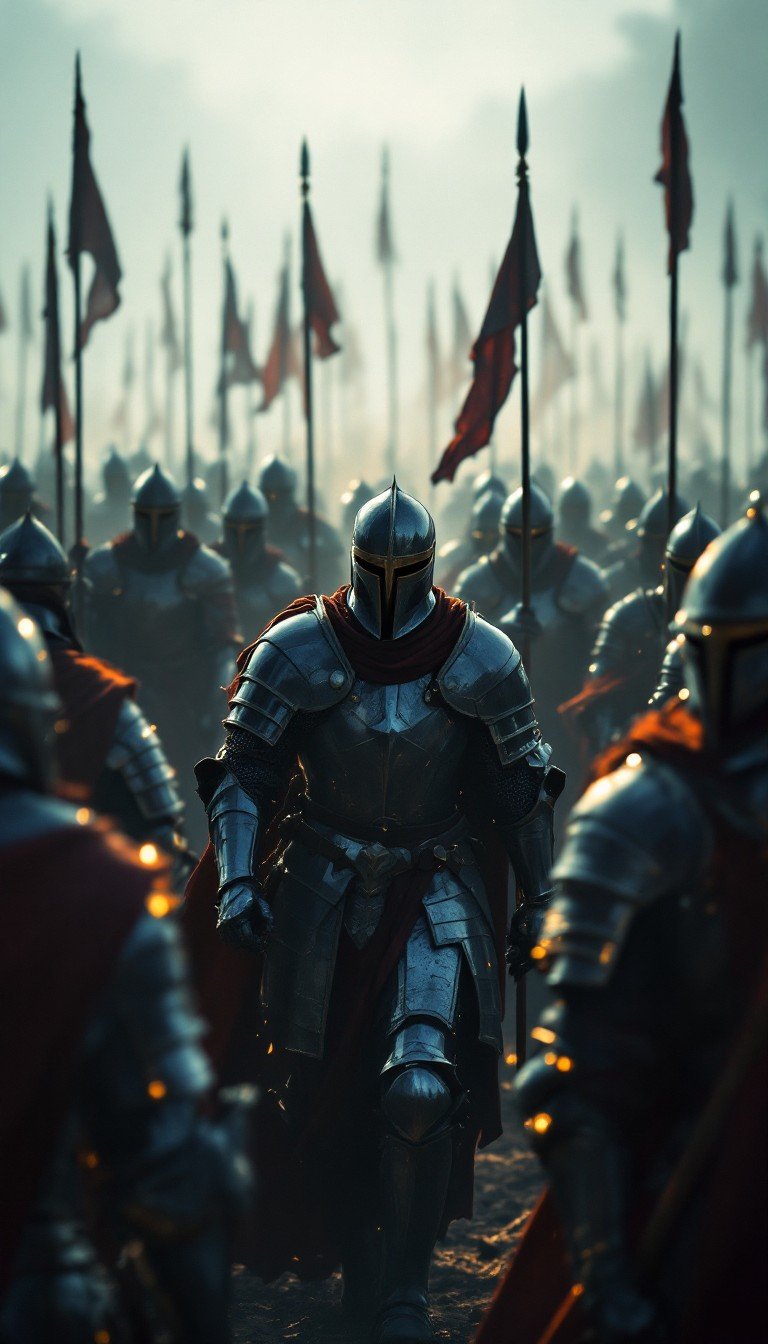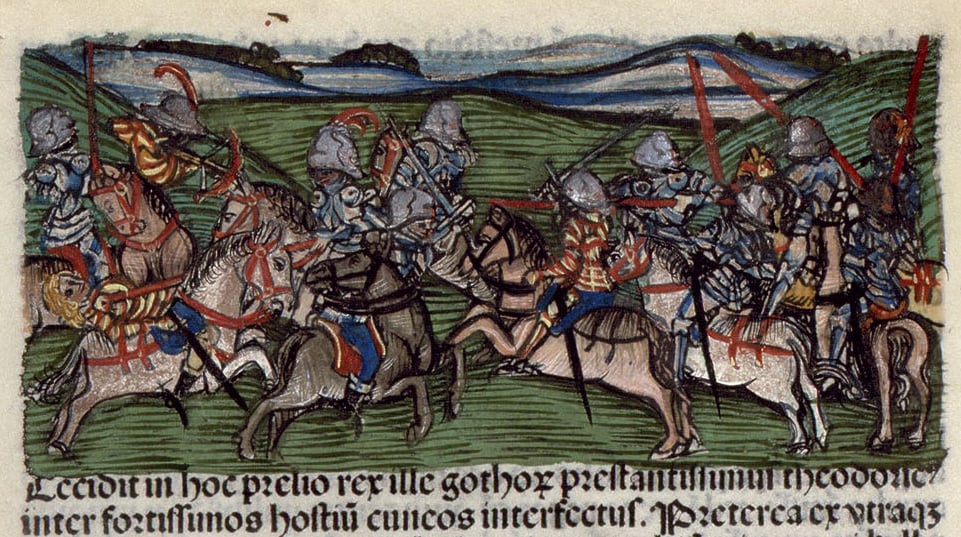Reimagining a Lost Battle

One of the challenges of writing about late fifth century Europe is the dearth of reliable source material. Many of the historical records have been lost, and where they do exist they are often fragmentary or distorted. Remember, this was an era where the panegyric and the hagiography reigned supreme, nakedly one-sided pieces of writing designed to lionize patrons and demonize enemies. Objectivity was not highly valued. Thus, it is difficult to get a handle on what really happened.
This is most frustrating when grappling with major historical events like the Battle of the Catalaunian Plains. This epic battle pitted Rome against the Huns and is one of the pivotal moments in European history. However, what we know about it is fragmentary or filtered through the accounts of contemporary chroniclers like Jordanes, who is notoriously unreliable in his reportage.
What Made Attila Different
To recreate the battle for my novel “The Desecration of Fortune” I had to scrape together what few facts have come down to us and presume the actual course of events. For example, in the months and years leading up to the battle, the Huns migrated west from the Balkans through central Germania, attacking and subjugating other tribes as they went. What made Attila different from his predecessors was his willingness to absorb these subjugated people into his camp as vassals, requiring them to fight on his behalf or face death. By this method his army grew larger with each conquest until it became a massive horde comprised of hundreds of thousands of warriors.
What brought Attila’s massive juggernaut to the attention of the Romans was the Huns’ penetration of Roman Gaul in 451 AD. However, what possessed the Huns to cross the border into Roman territory is unclear.
The Huns’ Motive for Invading
Prior to 451, the Huns’ conquests had mostly been outside Roman territory. As such they had not provoked a Roman response. They might have continued on this way. For example, the Kingdom of the Saxons lay just north of the Hun’s position during the winter of 450 AD and would have been ripe for the picking, but the Huns chose to turn west and cross the Rhine. Why?
Jordanes as usual offers an unlikely explanation, suggesting that King Genseric of the Vandals urged Attila to enter Gaul in order to attack the Visigoths. First, the idea that there was an open line of communication between the Vandals and the Huns seems a stretch. The Vandal kingdom lay 1,500 miles (2,500 km) from the Huns’ theater of operation. As such, the Vandals were far away from the action in northern Gaul and unlikely to have much interest in it. Second, friction between the Vandals and the Visigoths is not widely attested in this period, although there would be plenty of friction a century later, at the time Jordanes was writing.
A more reliable historian Priscus, writing closer to the events, records a succession struggle among the Franks in 449 AD which saw the elder of two brothers (and thus the heir apparent) ousted by his younger brother, who was backed by the Romans. It seems plausible that this older brother might have traveled 250 miles east (400 km) to meet up with Attila and offer his kingdom as a vassal state if Attila would help him overthrow his brother. To accomplish this the Huns would be required to cross Roman territory.
At the same time the Romans were putting down a series of tax revolts in Armorica (modern day Brittany in France). The leaders of the uprising were routed and fled. It seems entirely plausible they might have run to Attila to seek his help in throwing off the Roman yoke. To reach Armorica from east of the Rhine, the Huns would have had to cross northern Gaul.
In my novel I cite these as the reasons Attila violated Roman sovereignty and provoked a Roman response, although it is largely conjecture.
Where are the Catalaunian Plains?
The exact location of the Catalaunian Plains has long been a matter of debate. Scholars agree they lay somewhere in central France in the vicinity of modern day Reims. Given the sequence of attacks on Gallic cities attributed to the Huns they most likely lay south of Reims and north of Troyes in the Huns’ line of retreat after being turned back at Aurelianum (modern day Orleans). But this rests on the assumption that the Huns were indeed retreating when the battle took place. If so, why?
The Roman army was buttressed by allied forces, chiefly that of the Visigoths. In fact, the Roman army during this period was underfunded and stretched thin, fighting wars and uprisings throughout the crumbling Empire. Perhaps one reason Attila chose to invade was his belief that the Roman army was weak.
But the Romans were led by Flavius Aetius, one of the greatest generals in Roman history. Aetius was a master of diplomacy and strategy. His ability to cobble together a formidable fighting force from a mixed bag of mercenaries and allies was second to none, and his most formidable ally were the Visigoths.
The Visigoths and the Vital Role They Played
The Visigoths were nearing the height of their power at this time. Settled in southwest Gaul around the city of Tolosa (modern day Toulouse), they were an independent kingdom, although nominally beholden to Rome. Their territory lay close by the region the Huns were violating, and, therefore, directly threatened by them. Aetius persuaded the Visigoths to join him in repelling the Huns.
Although there is scant evidence, I conjecture the Huns got wind of the Visigoths advance while they were besieging Orleans and retreated east in an attempt to reach the Rhine and cross back over into Germania. The Visigoths caught up to them at the Catalaunian Plains.
According to Jordanes the Catalaunian Plains rose on one side to a ridge. In my novel I conjecture that the Huns chose these grounds not because of the high point of the ridge but because of the slope leading up to the ridge, which was littered with rock outcroppings. The Huns were superior riders and bowmen and would’ve wanted a large expanse of open ground to maneuver in. The outcroppings would’ve provided cover for their archers. Thus, the Visigoths would’ve been able to seize the high ground without much difficulty. But where were the Romans?
Reimagining the Battle
Jordanes tells us the undermanned Romans had been drawn off by a large company of Gepids who were allied to the Huns. The Romans engaged the Gepids in a skirmish that left 15,000 dead, but as a result were delayed in joining their Visigoths on the ridge.
In my telling, the Huns get the upper hand early on in the fight, but as the battle intensifies the Visigothic king is unhorsed and killed, which rouses the Visigoths to a fury, who fling themselves into the Hun lines like berserkers. Forced into hand-to-hand contact, the Huns lose the advantage of fighting from horseback and using their bows. The Visigoths push the Huns back and begin to outflank them on their right. As the Huns turn, the Roman latecomers arrive sweeping down on their left, and the Huns are enveloped and cut to pieces.
As night falls the Huns retreat to their camp, bloodied and defeated. The next morning they withdraw. The Roman chronicler Hydatius tells us 300,000 men had fallen.
Aftermath
For reasons unknown the Huns were permitted to slip away when they might have been attacked and obliterated. Knowing how Aetius had used the Huns as mercenaries in the past to help him fight his battles, I conjecture this was deliberate on Aetius’s part, but it had long term consequences. A year later the Huns were back on the offensive, invading northern Italy. They weren’t eradicated until after Attila’s death two years later in 453 AD.
What Might Have Been
Scholars debate the historical importance of the Battle of the Catalaunian Plains, but I can only imagine what the world would have looked like if the Huns had succeeded in penetrating deep into the Roman Empire. The ensuing destabilization would have caused the Empire to fall, and the resulting political landscape would have been dominated by a roving horde of bloodthirsty marauders bent on rape and pillage.
Despite the popular view, the post-Roman world of the early medieval era was not a messy free-for-all. Kingdoms like those of the Visigoths, the Franks, and the Vandals were well-established, ruled by laws and civic order. Had the Huns prevailed these nascent kingdoms would likely have been destabilized and might have been toppled, destroying functioning economies and setting civilization back by generations.
In my opinion the Battle of the Catalaunian Plans was a pivotal moment in European history. However, to recreate it I had to rely on imagination and conjecture, as well as what little reliable source material was available. I believe I have painted a vivid picture, which you can enjoy fully in the pages of my new novel “The Desecration of Fortune”.

